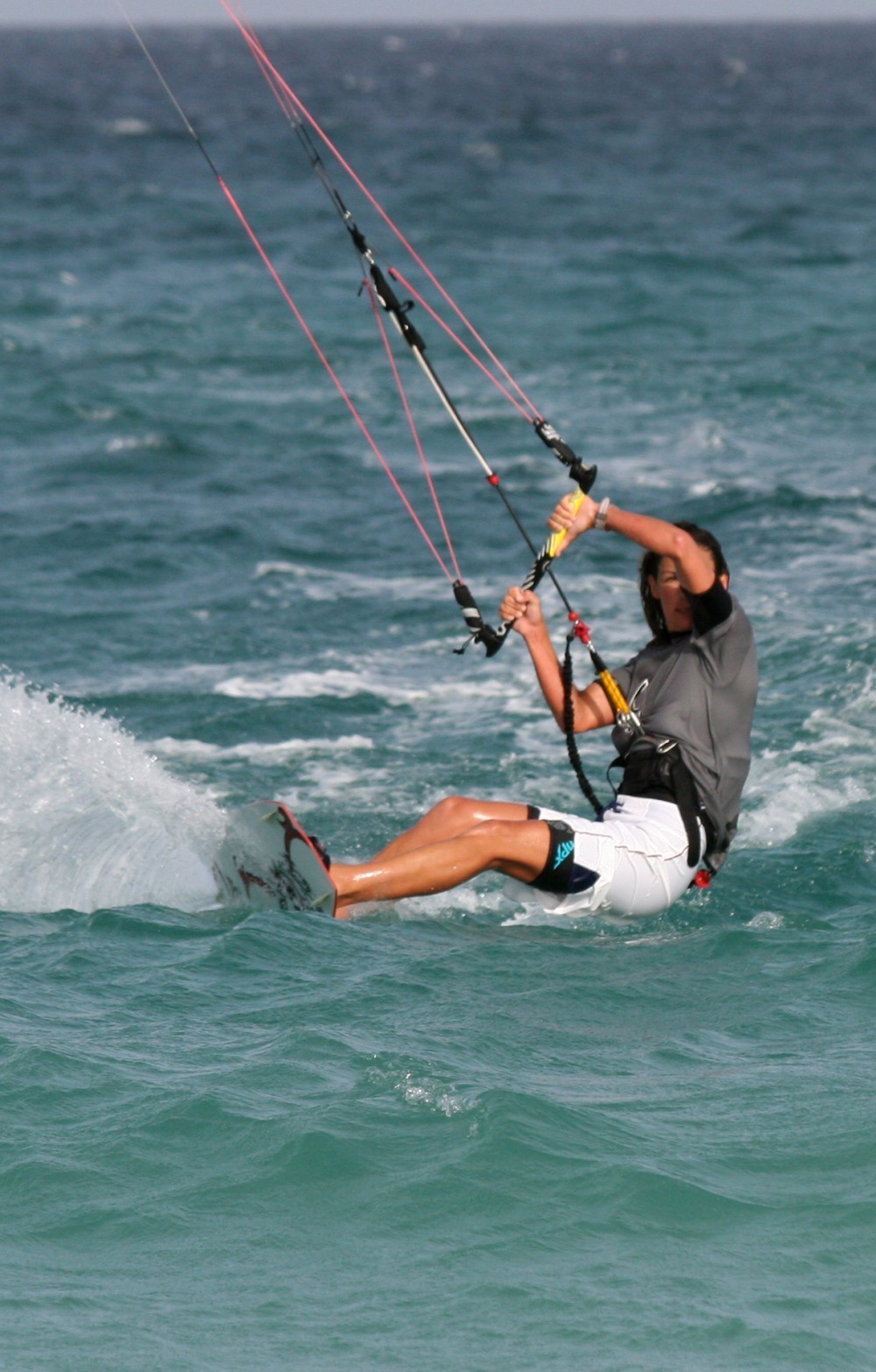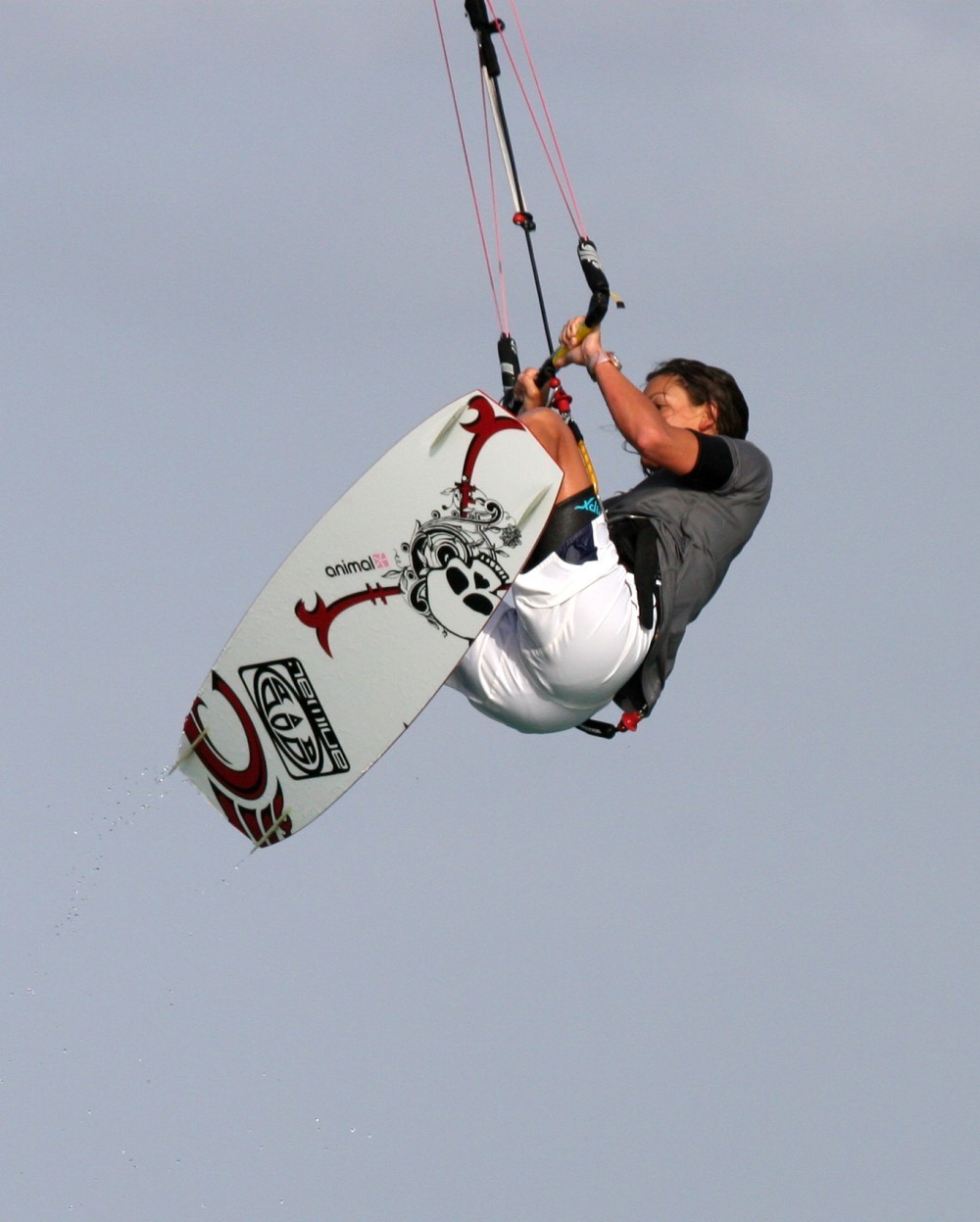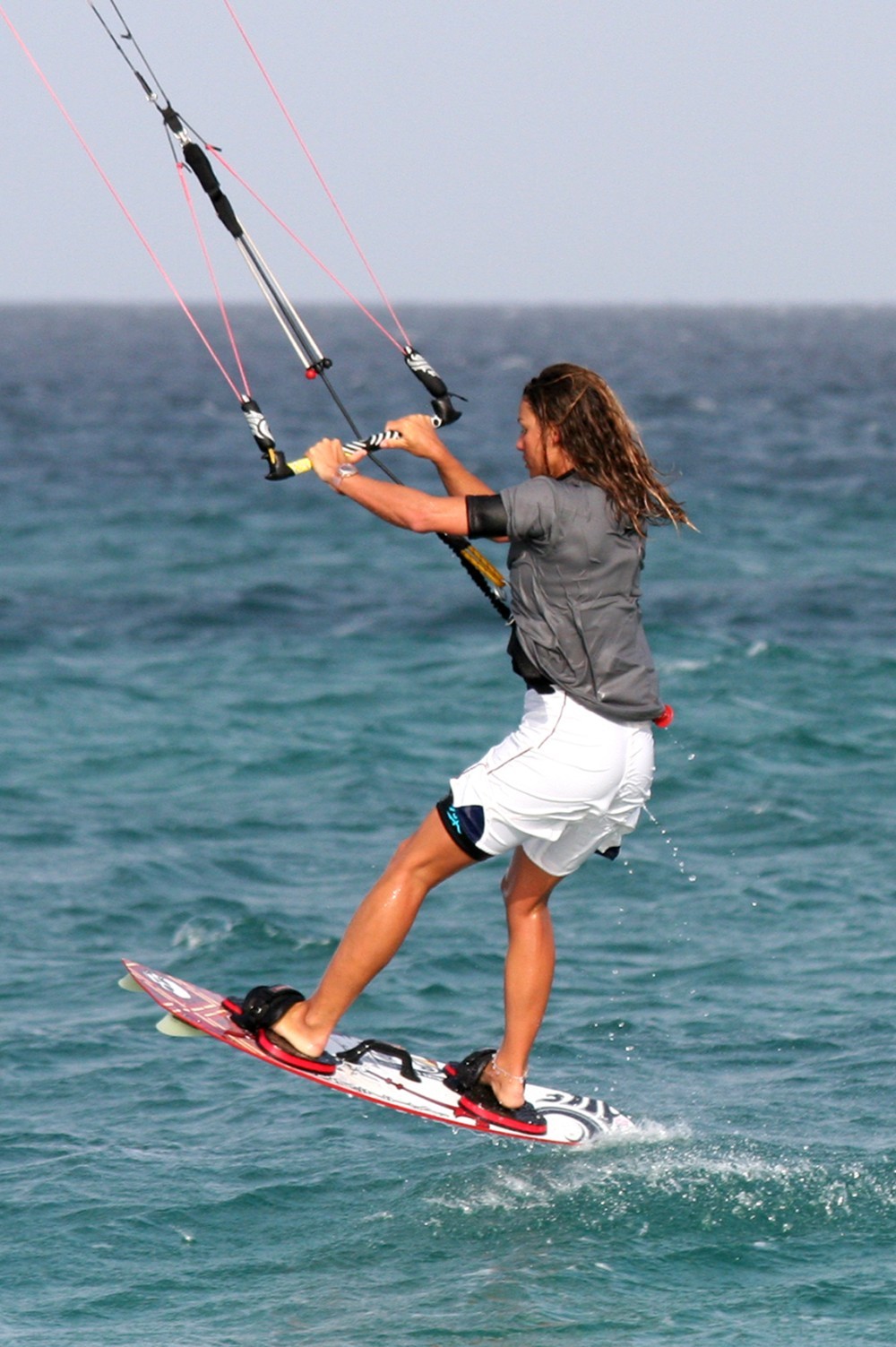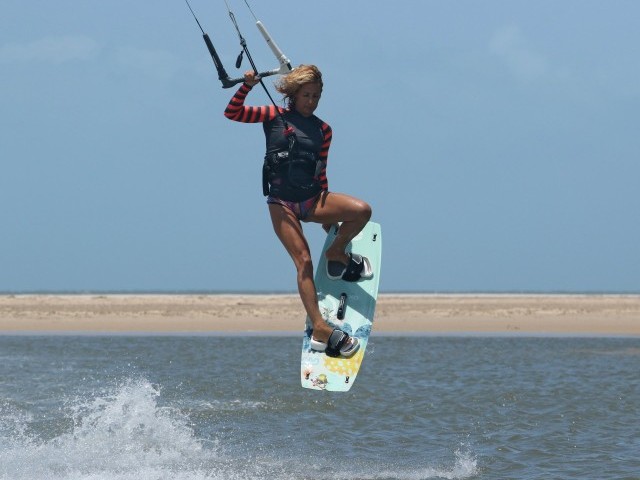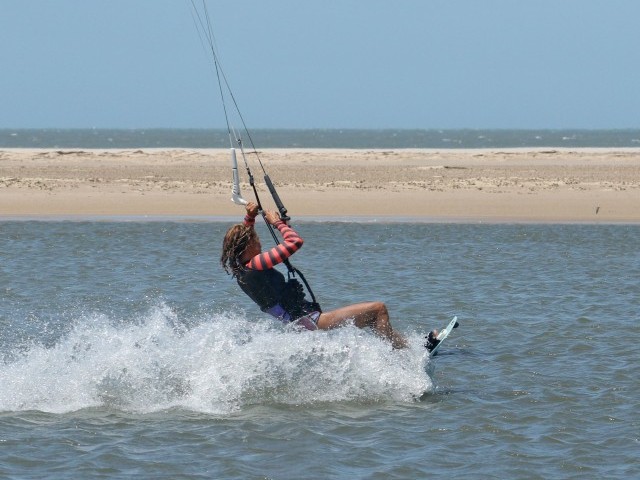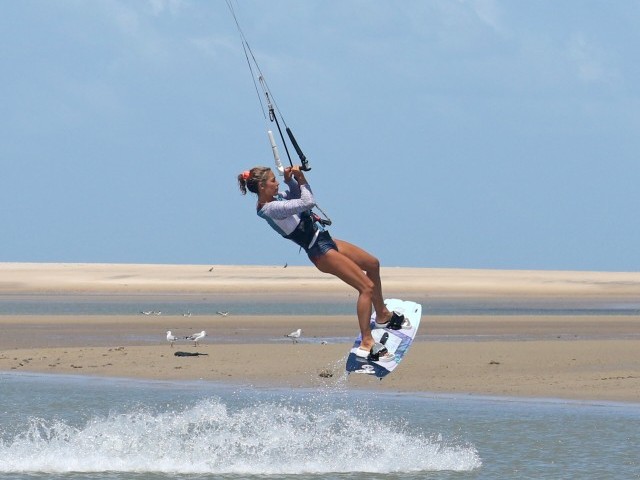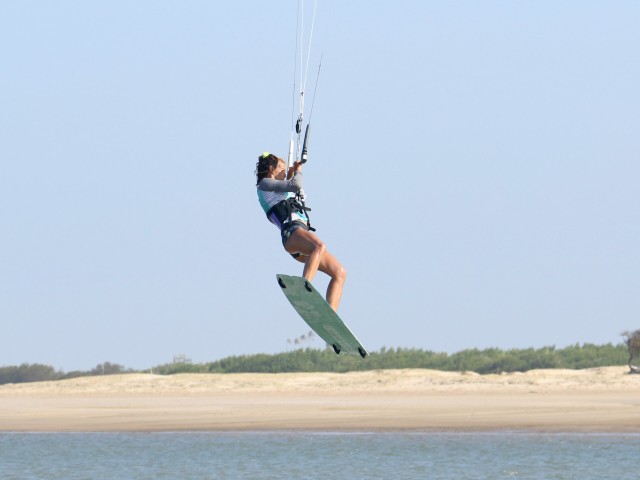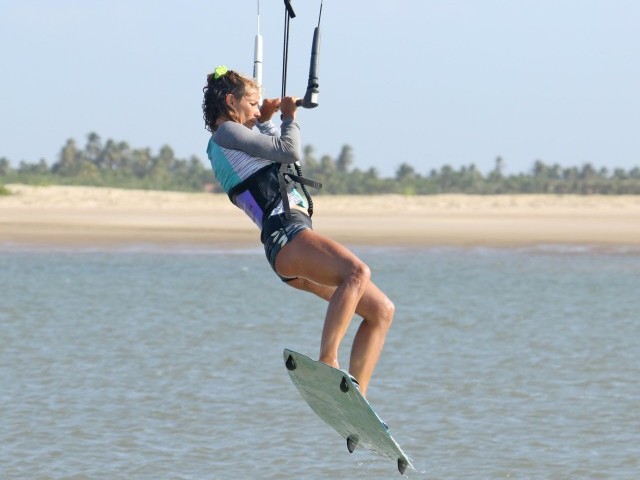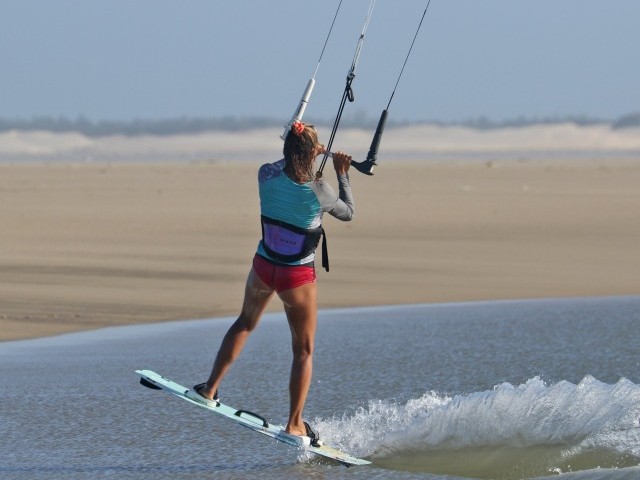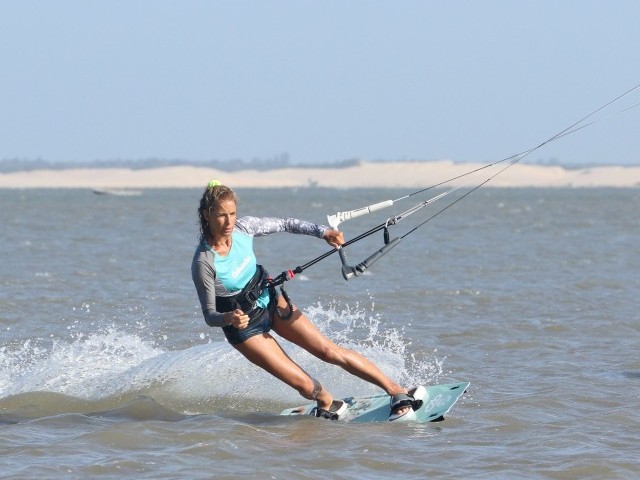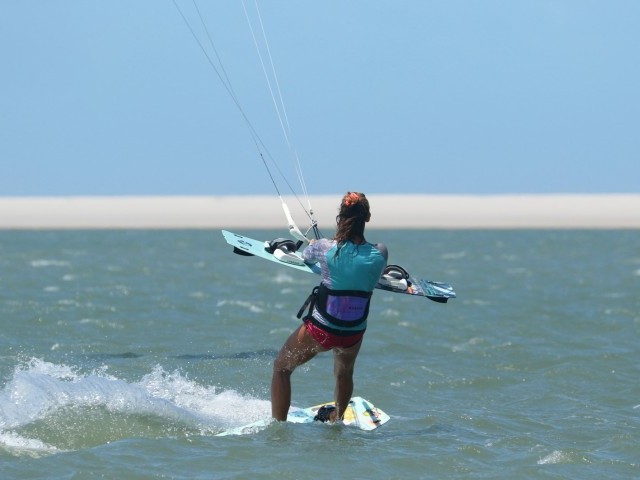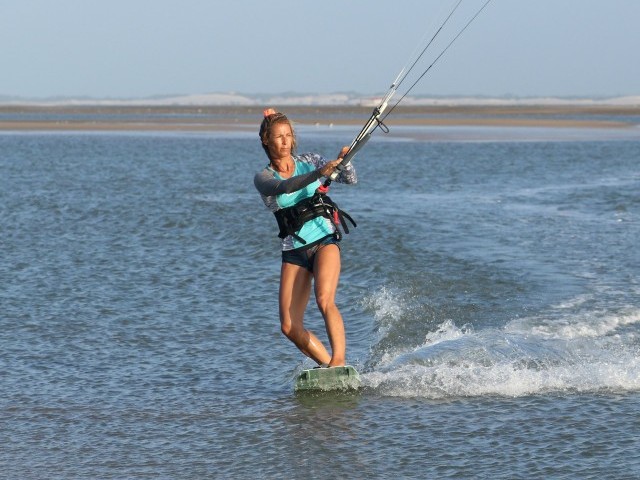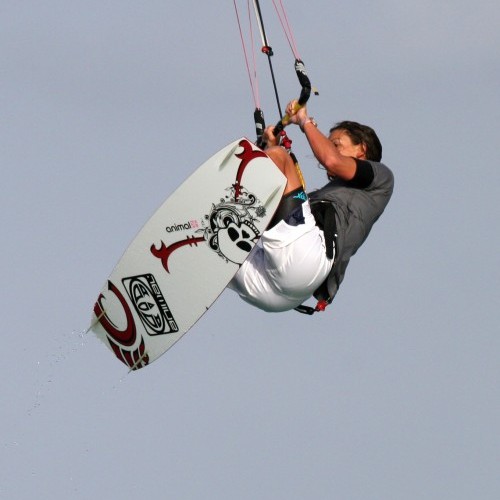
Jumping
Technique / Beginner
Jumping
Most of us would find it hard to deny the fact that it was jumping that originally flew the flag of appeal and suckered us into this amazing sport. No matter how much we improve, no matter how many crazy powered this or that’s we can pull, there is still nothing quite like airtime. From that first moment of frozen silence, however brief, to the occasional surprise biggy, hang time rocks and height looks spectacular.
If you are cruising around on your edge and can pretty much go where you want it’s definitely time to take to the sky! The only other prerequisite would be adequate upwind body dragging. You may well be leaving the board behind on occasions, but wearing a leash would no longer be sensible.
Kite Basics
Before hacking out into the big blue, let’s consider the kite’s task. Your kite needs to pull you up, off the water, preferably in an elevator style jump. This means that the kite will move from one side or another through the 12 o’clock mark directly above you. If the kite moves across in front of you, you’ll just get yanked off down wind. Depending on which way you are going the kite should start around 11:15 or 12:45. Much lower than this, you will find it difficult to hold your edge. Much higher and the kite will not pull us off the water until it has travelled too far behind us.
You also need the kite to generate extra power, which it does when it moves quickly. So you will need to be positive with your steering, pulling hard and aggressively to get it to turn suddenly. Although tempting when learning, if you are too gentle and merely drift the kite up, nothing will happen.
Whilst you manhandle the kite through the skies you still need the ability to control the power, or rather you only need to generate as much power as you can control. We need speed, it’s our friend, but for our first tentative steps so is control.
If you try using a tractor of an 18m, it will undoubtedly take a long time to turn, and as a result it will feel almost impossible to hold your edge, not ideal for learning. Like wise, if you try and move your kite from down by the water, to up above your head, no matter how quick it is, it will be impossible to remain in control. Finally should you have the bar set too far away from the chicken loop, you will not be able to get into a good edging position, or if you can you’ll be pulling so hard on the bar that the kite will “flare” (read: drop further back in the window) and pull you downwind.
Body Basics
As you may now have gathered, apart from controlling the kite, your aim is to keep the board hard on its edge as the kite moves. Your aim is to throw the kite back and then edge as if your life depends on it. If you try to progressively edge harder and harder before throwing the kite you are likely to stop.
Not wanting to simplify too much, but here goes anyway – it’s all in the head. Your biggest temptation when learning to jump will be chancing a sneaky peak at the kite as you send it back. Your stance up until now has been honed to carry you upwind. Now is not a good time to start bringing the head and shoulders up over the board to see what the kite is doing. The result of this will be a flattening of the board, which will allow the kite to travel too far behind you.
In Pic A we can see Karine’s stance during the crucial moments of sending the kite back. She’s looking upwind, over her shoulder as she would normally. However, rather than loving the bar with her hips, she drops them much closer to the water. This is to counteract the pull of the rising kite. She has also straightened her front leg; otherwise with her derriere low two bent knees would roll the board flat. This enables her to keep the board on its edge, driving through her back heel trying to push as much of the tail into the water as possible, turning the board hard upwind away from the kite. You can almost feel the lines stretching ready for the “ping” as the board grips the water.
To appreciate what is actually going on in the jump we will break it down into the following four stages.
1. The Approach
As with any move your approach should let you get balanced and fill you with confidence, so it should be comfortable. For the jump you should be travelling happily on an edge with reasonable speed and power in your kite. Don’t edge super hard upwind as this will kill all your speed. The time to grit your teeth and pull your kite face will come. Before you decide to go for it make sure your kite is no lower that 1 o’clock or 11 o’clock. If it is, move it up. That was your last chance to check on it before your get airborne. Make sure you have enough space around you should you drop the kite or go flying off down wind, and make sure the water is deep enough to fall into. All sounds pretty obvious, but if you’ve been sitting in the car, psyching yourself up on Iron Maiden and Red Bull some fundamentals may slip your mind.
2. The Take Off
This is the gateway to a whole new world and you may not know what to expect. The order is to send the kite back and then exaggerate your stance. If you are holding the bar at either end, it could now be time to start moving the hands inwards. There is no need to have your hands rubbing the chicken loop, but somewhere half way is ideal. With your hands more centred on the bar you can use both of then to steer the kite in a push pull motion. Most important of all you should not be trying to physically jump off the water, but rather resist with gusto (now’s the time for the face) and play the waiting game, looking upwind, keeping the power in close until the kite wins and pulls you up. Just remember not to look at the kite and all will be well. If you fly bows, it’s even more important not to let the bar pull away from you.
3. In Flight Entertainment
Once you are in the air you’ll need to get balanced and get the kite redirected so that it’s flying forward. Obviously you may be a tad excited and although it would be great to enjoy the view, silence and sheer brilliance of flying there are pressing matters to be attended. To make sure that the kite responds you’ll need tension on the steering lines so pull the bar down by bringing your hands to hips (another good reason to hold the bar more centrally). Chances are that this will also move the kite above you – you now have a parachute. At the same time you should bring your knees up to your hands, being small will stop you swinging off balance (Pic B). Finally try and work out where you think you will land and watch that patch of water. Spotting your landing like this will also help you keep your balance. On your first attempts, if you can get into the air, get the kite back above you, and then gently drop down into the water you’ve done the hard work.
4. The Landing
As you descend you need to drop the undercarriage, so try and judge when you’ll touch down, and just before you do, drop your legs underneath you. To get some power from the kite, dive it with the front hand. This will help pull you slightly and stop you sinking. Landing will be far more achievable if you can point the board downwind, so twist your front hip forwards to follow the kite and aim to land tail first (Pic C). If you don’t dive the kite it will just sit above you and you’ll land on your bottom. If you pull the kite gently with the front hand, the kite will move to one side above you and pull you off balance. The key is to dive it hard, but time this so that it’s just before you reach the water.
Following Sequence 1
- Pic 1. Karine approaches across the wind with controllable speed. She had a good look around and sets her kite just above the 11 o’clock mark.
- Pic 2. She now sends the kite back by pulling hard on her backhand, whilst keeping the bar close to her. She drops her bottom to resist the pull in the kite and carves as hard as possible upwind, exaggerating her stance, twisting upwind and peering over her shoulder.
- Pic 3. With her front leg almost straight, she drives through her back heel, fighting against the pull, keeping the bar pulled in. Now definitely at her most aggressive!
- Pic 4. As the kite starts to pull her off the water she continues to drive through her back foot, holding her edge for as long as possible.
- Pic 5. With the kite now moving back above and behind her, Karine is ripped off the water.
- Pic 6. As Karine ascends she brings her hands to her hips and evens out the bar to bring the kite above her. If you are missing the kite, now is a good time to have a peek and see where it is.
- Pic 7. She looks forward in the direction in which she is now flying to keep balance.
- Pic 8. Her legs come up so she will not swing off balance.
- Pic 9. Hands to hips, knees to hands, kite above her – nice!
- Pics 10 & 11. Karine Keeps focused on where she will land.
- Pics 12, 13, 14. As She descends Karine drops her legs so they are underneath her, She pulls on the front hand to give her some forward momentum to land with, and point her board downwind to make for a smooth landing.
- Pics 15,16,17. Karine lands pointing down wind, tail first, absorbs the impact with soft knees which stops her bouncing, and carves back round onto her heel side edge whilst checking to see where the kite is.
As you confidence and ability rise someway down the road you can start to add some pop into your jumps by flattening the board as you send the kite and then carve very hard and very suddenly into the wind.
Common Problems
There are many factors and combinations that can prevent good jumping, but here are some of the most common.
The Kite Flying Way Too Far Behind You
- If this is the case you may be underpowered and therefore the kite needs to travel a long way before generating any lift.
- If you are bending both legs or sneaking cheeky peaks at the kite, you will loose your edge and therefore the tension in the lines, so yet again back it goes.
- If you start with the kite too high, it will need to travel back before lifting you.
- Sheeting the bar out, that is to say pushing the bar away from you.
- Freezing on the backhand, and forgetting to redirect the kite.
Loosing Your Edge Before Take Off
- Starting with the kite too low.
- Carrying too much speed into the take off.
- Not exaggerating you stance enough.
- Looking at the kite.
- Sending the kite back too gently.
- Not being aggressive enough with the back foot.
- Trying to jump up with the kite.
Not Sailing Away From Your Landings
- Landing on the edge, and not pointing the board downwind.
- If you are loosing balance you may not be diving the kite enough with the front hand.
Final Words
A massive jump will impress your next of kin more than the latest powered move. So if you have been concentrating on “new school” and you know your jumps need some polishing, do your self a favour and sort out big air. It will complete the box of tricks and is best done when too powered for all the other stuff anyway. Happy Flying.
This technique article was in Issue 3 of IKSURFMAG.
Related
By Christian and Karine
Christian and Karine have been working together as a coaching team, running improver to advanced kitesurfing clinics since 2003.







